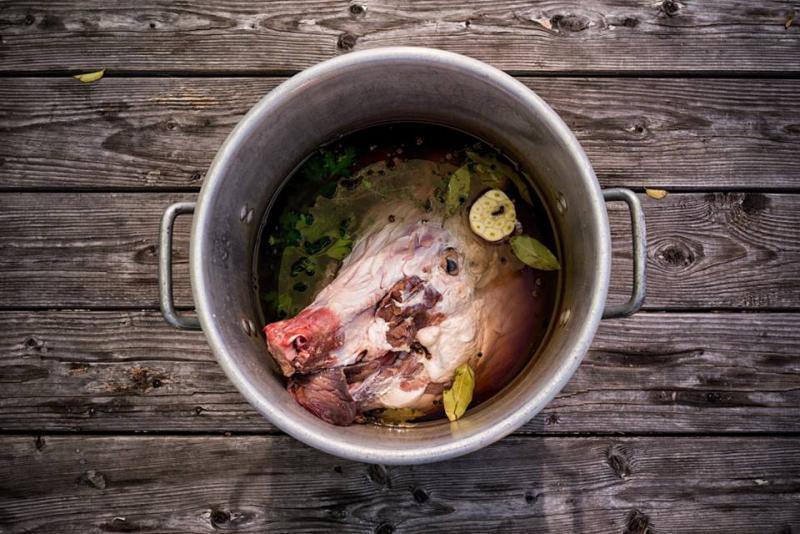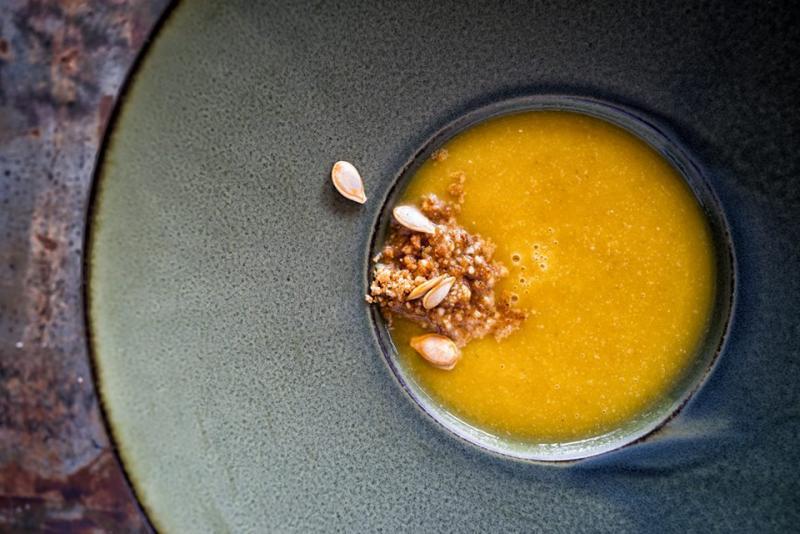-
Posts
6,155 -
Joined
-
Last visited
Content Type
Profiles
Forums
Store
Help Articles
Everything posted by gfron1
-
My comment about apple v. pear is about structure and texture. I'm just suggesting that you throw a fairly neutral base in with it.
-
You can drop the booze but its so weak that it won't be noticed as far as the alcohol. Can you do an apple puree/sauce?
-
My standby: 1/3 C Juice - can be lemon, apple, orange... 130 g (4.6 oz) Sugar 4 Sheets silver gelatin (1.75 tsp) 30 ml (1 oz) limoncello (calvados, grand marnier) 355 ml (12 oz) Cream Heat juice to a simmer; add softened gelatin; cool to room temp (I do all of this in the micro btw, which drops it down to 60 seconds. Add booze. Whip cream to soft peak; add a quarter of the cream to the juice and combine; add the juice cream mixture to the rest of the cream and fold carefully. *Just a note that generally I find 1 sheet of silver equals 1 tsp of powder. For some reason, in this recipe I double the sheet gelatin to get it to set up like I want - which is almost always for a cake layer. Edited to add that I would cut in some pear puree - like a 1/4 C with the juice.
-
I am in an odd town. My partner always says he's going to write a Mapp and Lucia style book of the characters around here.
-
Lately we've had customers asking if they can taste this or that. It started out as soups, which while a pain, was not terrible. Lately its sauces. Sometimes its a sauce like our house made ketchup or mayo, which is more of a pain, but still ok, but also the sauce that some of our meats is cooked in. Is this normal? Its starting to drive me crazy - one for the stop in work flow, but also the audacity. Am I off base...service with a smile
-
That makes sense - thanks. Today really has been a tremendous day. With that new organization, every recipe fell into place. Every essay fell into place. Nothing felt forced or arbitrary anymore. The first section feels really exciting - heavy photo essay with written support that covers how to forage, ethics and finding your voice as a cook. And now I'm at roughly 75 dishes - 25 per section mas o menos. I've already reorganized our DropBox files to account for the changes and have my to do list of recipes which is much more clear. My photographer is psyched that he'll play a more prominent role, and that he can use many of his existing pics. My editor is psyched because we seem to have a direction for the story. And my designer is psyched because...well, soon he can start doing something. Twas a good day indeed.
-
Meaning, replace it with the & symbol?
-
Good morning thoughts. I mapped out my essays and recipes to find themes and commonalities. I ended up with plants: wild and farmed and meats: wild and farmed. This is obvious but really useful. I've reworked the sub-title which feels more natural than anything we've had to date: Acorn & Cattail: A Modern Cookbook of Farm & Forest I'll sit on that for a while. EDIT: Already evolved as I fit the recipes into the new categories: A Modern Cookbook of Farm, Forest and Field (think animals, farmed plant and wild plant)
-
Sorta random thought. The vast majority of people do not use a cookbook from page 1 to page last regardless of how the recipes are structured. You jump around based on what sounds interesting to you. So why do we do Tables of Content in structures like we do (Appetizer, Entree, Dessert; Spring, Summer, Winter; Easy, Medium, Hard). We're toying with the idea of more of a Venn Diagram concept - grouping by interest. We're not quite sure what this looks like, and we're sure it'll give the publisher fits, but we're doing some graphic concepts on the idea. This all came about because I was saving each recipe as an individual document file. Now that I'm up to around 75 recipes, that's cumbersome for editing. I want to group the recipes by chapter - putting all content for each chapter in its own file. Before I do that, I need to be very confident that I like the groupings...which I currently don't. Am I offbase here? BTW, I do hope all of my blabbering is useful or interesting. I think its fascinating seeing what issues come up as we work through this book - things that I never imagined.
-
Interesting story on the various approaches to recipe writing from Madfeed.
-
If you can find canned, there's a decent chance that you can find frozen. I believe I've seen it from Goya.
-
Based on your screen name I assume I can give you the abbreviated version. Sweat a half of an onion. Add half cup of cuitlacoche. Add a cubed butternut and sauté for 5 minutes. Add 2 qt rabbit broth (or whatever broth) (or enough to cover plus an inch). Simmer for 30-45 minutes or until tender. Blender and sieve. Salt to taste. As with most of my recipes I like pure flavor hence no other seasoning. Wouldn't it be great if I could write all recipes like this No vouching for canned cuitlacoche - never used it. I have used frozen and found it to be acceptable.
-
Today I submitted a proposal to an agent. I hate the idea of giving a percentage away - but I'm anxious to see what doors might open. I've also been talking about paper with my designer - he's leaning 100# matte stock. My designer wants 10x10, but the publisher who is courting us wants a more standard 8.5x10. I don't know that I care either way, its a matter of fashion v. function. What do you all think?
-
Short answer - yes.
-
I really appreciate that comment Deryn, and will certainly be a part of my push back with publishers. I'm trusting that they know how to sell books, but what's the point if I can't be proud of what I'm selling.
-
Another great photo shoot yesterday. The publisher who is courting me asked only one question - is that enough recipes? Its the question I've been struggling with for months. On one hand I'm not a Michelin starred chef who can throw out a coffee table book that world would want to devour with only a handful of recipes and a slew of ponderings. On the other hand, I'm not trying to present "150 Great Cupcake Recipes for the Holidays." I'm somewhere in between. As I said up thread, I want this book to be 75% accessible and 25% inspiration. And I also recognize that some recipes are actually a set of 3 or 4 recipes. Many people say that 100 recipes is ideal, but this book is more than a set of recipes - its a collection of food, people and place, yet I need to keep a more universal interest than my local community. Just thoughts. I'm going to dig through my old blog and see what recipes are buried away, and I'll continue to add recipes as the foraging season changes. This photo is my huitlacoche butternut soup with miso soil.
-
I still use your technique and make monster batched a few times a year. Every time I do I think of you!
-
One of the things I'm most looking forward to is showing folks how to use common foraged ingredients. I spend quite a bit of time on green walnuts in the book. Been swamped with restaurant life - had a JBF judge come through on Thursday and a huge dinner tonight that has been sold out for months. I'm really, really hoping to get my recipes 100% complete by Monday so I can relax and start getting some sleep again. The irony of it all is that since I started working on the book, my foraging hikes have gone down from 6 a week to 2 a week at best.
-
I just asked my server what she says. Her response, "The chef puts those out fresh every morning." I responded, but there are day olds in the front of the line of cookies. And she responded, "yeah, but I don't know where the day olds end and new ones start." Not sure I like that answer, so this turned out to be a good impetus for us to talk about the issue.
-
Another interesting day. We're exploring relationships with publishers. Today I spoke with a small, but growing publisher. The model of my team doing all of the work (photography, design, edit) is not normal - we knew this - and it makes it more difficult for a publisher because their financial model is based on them doing much of that work. In a traditional model she said that the royalties would typically be 12-16% but she would have to re-calculate. Quick math runs through my head - if I sell one book at $35 I would make $5.25...split evenly among my 3 other partners equals $1.31 per book. Sell 1000 books (low end estimate) and I make $1,310. Sell 5000 books (realistic estimate) and I make $6,550. Keeping perspective that really our team would make $26,200. She said our percentage would be higher but she has to figure out what that might look like. When we were only looking self-publishing I was able to think in terms of per book profits in the $20 range after printing and distribution. The appeal of using a publisher, no matter how small, is that they have established printers and distributors, as well as some form of marketing. The exciting thing about this conversation, however, was that they had in vain been looking for a premier cookbook for next Fall and she felt it was a good fit. I'm cautious because I would think other publishers would feel the same way, but the fit isn't too bad with this one. I also talked to her about how many recipes, how many pages, how many photos and we're in the ballpark for a 200 page book. My mind is a bit more at ease right now!
-
There are a number of chefs who work yeast in as a flavor. Mainly I see it going into dairy products where the flavor is best suited. I've seen ice cream/gelato, creme fraiche, yogurt spheres, etc. Think of a recipe where it will have a minimal or nil effect on the food - ie, don't put it in dough or anything that will really activate it. The one time I did it was a dish where I infused, then gelatin filtered for a clear broth...essentially creating liquid bread for a cocktail. So yes, you are on a track that has been gone down before, and very successfully. Typically regular dry active is what's used...different flavor than a self-started starter.
-
I'll expand that question to the larger list of ingredients represented in the book. Whether we're talking cattails, acorns, sumac, yucca, agave. algerita...etc., each has a unique flavor and texture that are simply unknown to most people. I'm focusing on the most accessible of the foraged items, but hoping to introduce folks to ingredients that are available, but mostly likely not used. And more importantly, most books in the US that have foraged foods are much too homestyle - yes, there is Manressa and a few others but then the focus isn't on foraged items - they are secondary. Specifically, cattail has a great cucumber-like flavor that is big moisture. Its a very versatile ingredient. The ash, like most ashes, tastes like...yes, ash, but they all have their own uniqueness that can be teased out, which is something I try to do by talking about different treatments. A great example is 4-wing salt bush which I use in place of salt throughout much of the year in my restaurant. BTW, you want to know what gets me even more excited - hackberries! I think they're one of the most perfect foraged flavors. Its like a date dancing on your tongue. Hope that answers your question. And, thanks again for these comments - so helpful!
-
Damn - I guess I'll re-write. Yes, free form, but should be 1/8" (1-2mm)
-
I wonder what my editor will say about optional ingredients - that aren't even in the ingredient list. I was also thinking about these comments - I often respond before fulling digesting. I would say that 75% of the recipes are intended to be fully accessible and the remainder are meant to be more for inspiration. In those 25% I don't feel its appropriate to offer substitutions because at that point its not what I intended.
-
I appreciate the feedback, and some of these things are adressed throughout the book - you're getting a snapshot out of context. Elsewhere I go into great lengths about why I like rice bran oil, but that canola is a perfectly acceptable substitution. The hard to find ingredient issue is one that I'm watching with every recipe. Acorn can't be substituted, but Okinawa black can. And I'll make sure that I offer more of these suggestions throughout the book. I do intend this book for the advanced home cook and restaurant cook. Part of the appeal will be the photos, part the foraged factor, and part the regional taste. As i continue discussing the project with potential publishers I'm getting to hone a message that is sellable, but still authentic to what I'm doing. All that said, here's a much more accessible recipe from the book for folks to play with. I offer this one because, while easy, it has a trickiness to it that would be interesting to see how it works for you all. You'll see its further along in the editing process and has those substitutions that you're asking for.






